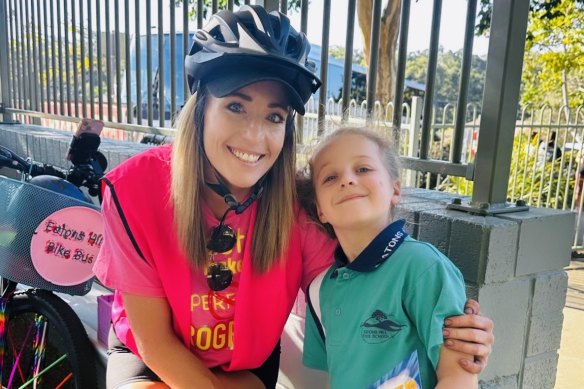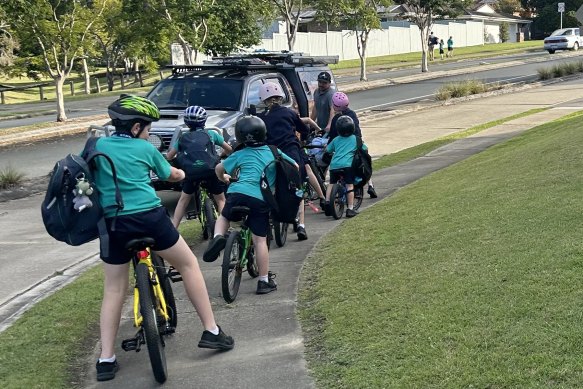- Perspective
- National
- Queensland
- Schools
‘Created a movement’: Old-school idea helps avoid car drop-off lines
It’s early one morning in a suburb north of Brisbane, and not only has a six-year-old boy woken up before his parents, dressed himself and started making avocado on toast for breakfast, but he’s desperate to get out the door to travel to school.
Mindy Robinson’s grassroots joyful bike bus has children riding their bikes to school again, like they used to 40 years ago before the taxi of mum and dad became the norm.
Like a regular bus, a bike bus transports children to school, except everyone rides a bicycle, and the “bus driver”, or drivers, are adult volunteers who guide the group along a set route to school.

Mindy Robinson leads the volunteer Eatons Hill bike bus.
Riding in a group ensures safety on roads, opposed to one or two children riding alone.
A physical education teacher in the US, Sam Balto, is the world’s best-known bike bus organiser, with his Instagram and TikTok posts showing hundreds of kids head-nodding to Taylor Swift and Uptown Funk through the streets of Portland, helping families avoid “soul-crushing school car lines”, as he told Today last month.
As Australian communities organise their own bike buses, they’re discovering red tape and obstacles. But it’s not impossible.
Robinson, a mum-of-three, launched a bike bus in the Moreton Bay suburb of Eatons Hill in late April with five children showing up, and numbers have more than tripled since then.
She said her two older boys, Hunter, 8, and Ashton, 6, had asked to ride their bikes to school, and after stumbling across the bike bus concept via one of Balto’s videos, it became “so much more than just getting my boys to school”.
With music pumping and kids laughing and enjoying the fresh air and exercise away from screens, the total ride is four kilometres, with stops along the way to collect more children, and a return journey in the afternoon.
“These kids are developing friendships, overcoming fears, gaining confidence, feeling included, learning independence,” Robinson said.
One parent said their child was “up, dressed and trying to make himself avocado toast all before I was even awake this morning”.
“He seriously loves the bike bus days,” they said.
“He’s never like this in the mornings.”
But starting a bike bus in Australia comes with red tape, such as waivers, Blue Cards and insurance.
“Our duty of care and public liability laws differ so extensively compared to that of the USA,” Robinson said.
“It would be lovely if we could gain some support or grant from our government to help officiate this into a program where local parents can sign up as volunteers without the worry of having all fingers pointed at them should a mishap occur.
“This is something stopping further bike buses from being set up in other suburbs, given a large portion of risk falls on the volunteer.”
The roads are also different in Eatons Hill versus Portland.
In Eatons Hill, the twice-a-week bike bus sticks to footpaths and uses lollipop crossings, whereas Balto in Portland uses neighbourhood greenways, which have speed bumps, a 32km/h speed limit, signs, and traffic diverters to reduce cars on the road.
Despite the complexities of starting a bike bus, Robinson said the rest was “easy”, and the bike cage was filling up as more parents and kids started riding to school, some independently of the bike bus.

The Eatons Hill bike bus keeps to the footpath for safety, whereas Sam Balto’s bike bus in Portland in the US uses neighbourhood greenways, with slower speed limits and speed bumps that are preferred routes for cycling and walking.
“I knew we had a doable route, I had availability, the interest from kids, and most of all a great community that would be interested,” she said.
“If you are passionate about it, you want it, you will find a way around it to make it happen.
“I would confidently say we have created a movement.”
The school commute in Brisbane makes up one in four car trips during morning peak hour. It’s no wonder the roads are so much quieter during school holidays.
Bike buses – and walking buses – are an opportunity to reverse a growing trend of kids being chauffeured to the school car drop-off point.
While riding en masse surrounded by alert volunteers is one way to get kids out of cars in areas where it feels unsafe to ride or walk next to fast-moving traffic, there is still an urgent need to add more footpaths and off-road and separated bike paths in our suburbs.
Because not every school has parents who are enthusiastic and have flexibility to volunteer their time to empower children to walk or ride to school together, despite unfavourable conditions.